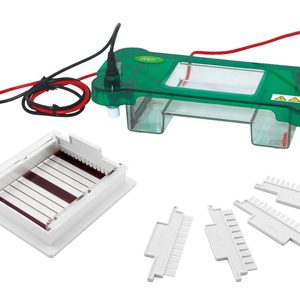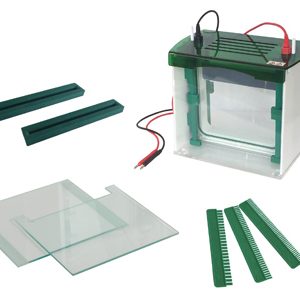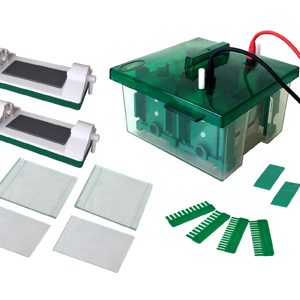Electrophoresis
Electrophoresis is one of the main molecular biology techniques, they are considered the most used technique in laboratories in everything related to nucleic acid research. Using electrophoresis, we can separate DNA and RNA fragments based on their size and electrical charge through their migration through a porous material (gel), visualize them by staining, and determine the content of nucleic acids or proteins in a sample. , thus having an estimate of its concentration.
The porous gel used in this technique acts as a molecular sieve that separates the larger molecules from the smaller ones. Smaller molecules move faster through the gel while larger ones are left behind. The mobility of the particles is also controlled by their individual electrical charge.
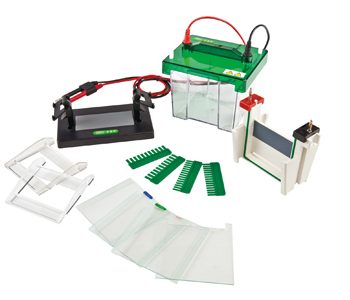
Types of Electrophoresis a Laboratory May Need
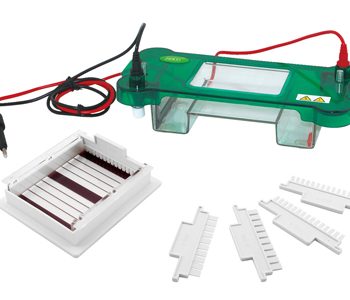
Horizontal
Horizontal gel electrophoresis uses the basic theory for the separation of DNA, RNA or protein molecules according to their respective molecular size and charge. In this technique, the gel is present in a horizontal orientation and is immersed in a buffer that is continuous. The agarose gel is used to separate the gel box into two compartments.
In horizontal gel electrophoresis, acrylamide cannot be used as the gel box is exposed to oxygen. Due to the presence of oxygen, acrylamide polymerization is inhibited, which interferes with gel formation. Horizontal gel electrophoresis is an effortless method used in the separation of DNA and RNA.
Vertical
This technique uses a discontinuous buffer. A cathode is located in the upper chamber, and the anode is located in the lower chamber. The electrodes present in each compartment provide the required electric field. A thin layer of gel is poured between the two mounted glass plates. Therefore, the upper part of the gel is immersed in the upper chamber, and the lower part of the gel is immersed in the lower chamber.
In vertical gel electrophoresis, the buffer only flows through the gel. Acrylamide gel can be used as the compartments are not exposed to atmospheric oxygen. Due to the smaller pore size of the acrylamide gel, precise separation can be achieved with higher resolution.
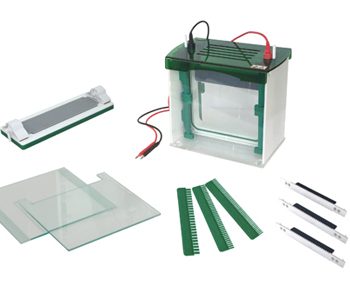
In Kalstein you can find the ideal Electrophoresis for your Laboratory
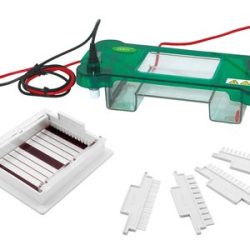
Horizontal Electrophoresis YR03416
YR horizontal gel electrophoresis units have been designed by scientists with the laboratory environment in mind...
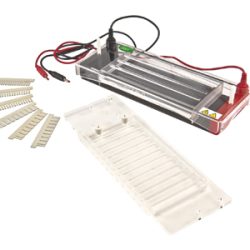
Horizontal Electrophoresis YR03422
YR horizontal gel electrophoresis units have been designed by scientists with the laboratory environment in...
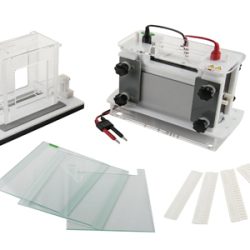
Vertical Electrophoresis Tank YR03432
Vertical gel electrophoresis is a more complex set-up compared to horizontal gel system. Researchers normally...
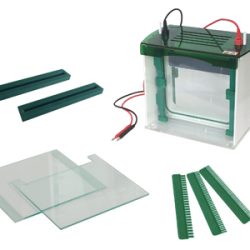
Vertical Gel Electrophoresis Cell YR03429
Vertical gel electrophoresis is a more complex set-up compared to horizontal gel system. Researchers normally...
Our Best Selling Electrophoresis
The DNA, RNA, or proteins that must be separated in this method are run through a gel that contains small pores. The molecules are driven through the gel by an electric field. The molecules pass through the pores of the gel, and the speed of movement is inversely proportional to their respective lengths. Therefore, molecules with a lower molecular size will move faster than molecules with a higher molecular weight. The electric field is generated by the difference in charge at two ends of the gel. One end contains a positive charge, and the other end contains a negative charge.
In horizontal gel electrophoresis, the gel is present in a horizontal orientation and is immersed in a continuously operating buffer that is present within the gel box itself. In vertical gel electrophoresis, the buffer system is vertically oriented and discontinuous with two chambers present at the top and bottom with a cathode and an anode, respectively. This is the key difference between horizontal and vertical gel electrophoresis.
| Model | YR03432 |
| Gel Size(W×L)mm | 173×195 |
| Gel thickness | 1,1.5(mm) |
| Comb wells | 21, 35 |
| Gel capacity | 2 |
| Buffer requirement | 2200(ml) |
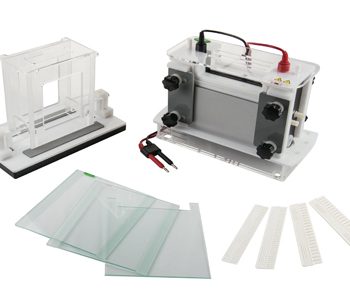
Analysis of the best Electrophoresis for your Laboratory
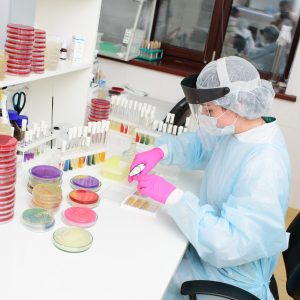
Anemia detection with the use of Electrophoresis
If the proportion of red blood pigment and/or red blood cells in the body is too low, there is anemia. The...
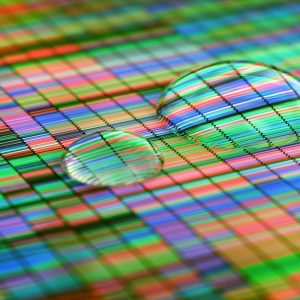
How does electrophoresis work molecularly?
Functionally electrophoresis is a technique that consists of proportional migration of molecules through...
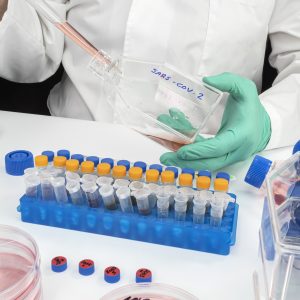
Electrophoresis Applications
Electrophoresis is a laboratory technique in which a controlled electric current is used in order to separate biomolecules according to their size and electric charge...

Electrophoresis Power Sources: How does it work?
A power source for electrophoresis is the source that manages constant and direct current to the ...
Electrophoresis models catalog on offer
-

Horizontal Electrophoresis YR03419
-

Horizontal Electrophoresis YR03416
-

Vertical Gel Electrophoresis Cell YR03429
-

Cellulose Acetate Membrane Horizontal Electrophoresis YR03424
-

Mini-Protean Vertical Electrophoresis Cell YR03427
-

Horizontal Electrophoresis YR03417
-

Horizontal Electrophoresis Cell YR03415
-

Vertical Electrophoresis Tank YR03428
Guides to Becoming an Electrophoresis Expert
Electrophoresis Run Power Sources
Electrophoresis in agarose or polyacrylamide gels is one of the methodologies most used in the laboratory in...
what are the necessary reagents?
Electrophoresis is an analytical technique in which a controlled electric current is used in order to separate...
Electrophoresis and Gel Documentation
Gel electrophoresis is a widely used technique in life science laboratories to separate macromolecules such ...
Electrophoresis equipment: What are its types and applications?
These equipment are used in scientific laboratories where a technique is performed to separate DNA, RNA, molecules and proteins based on their size and electrical charge; it does a process by using a gel that acts as a colander, which by means of a current makes.

Frequently Asked Questions about Electrophoresis
How to know the prices of Electrophoresis?
To know the price of Electrophoresis we invite you to send us an email with your request through the contact form.
What are the delivery times of the Electrophoresis?
- If the equipment of your interest is in stock or if it must be manufactured.
- The type of freight you have chosen, this may be; air or sea.
How to make a purchase of Electrophoresis?
- By email: [email protected]
- By telephone: +33 (0) 1 78 95 87 02
- E-commerce: Via Kalstein's official website in your country.
How does the warranty work?
Can I request a quote online?
Of course, you can request a quote for the Kalstein team of your interest, directly from our official website. Once you have identified your preferred model, click HERE
Send us a direct message and one of our agents will contact you
Error: Contact form not found.


